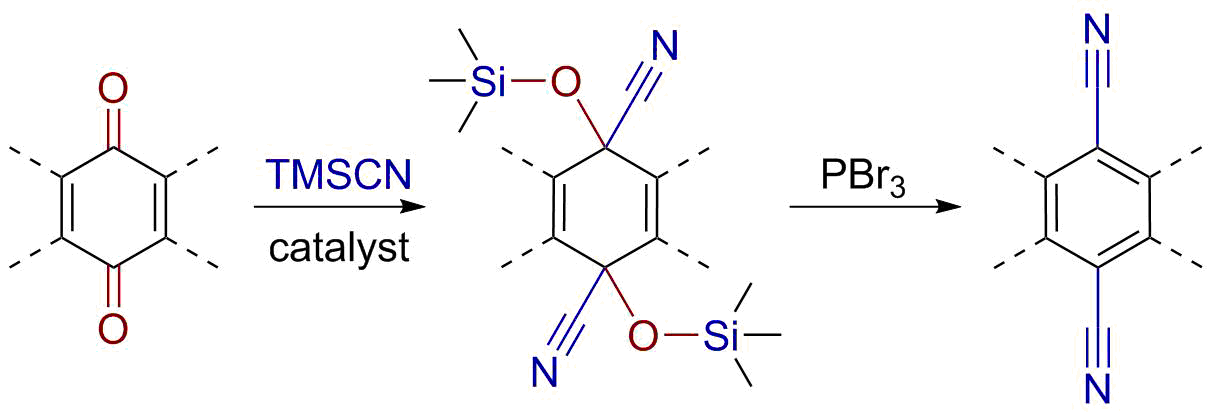|
Ammoxidation
In organic chemistry, ammoxidation is a process for the production of nitriles () using ammonia () and oxygen (). It is sometimes called the SOHIO process, acknowledging that ammoxidation was developed at Standard Oil of Ohio. The usual substrates are alkenes. Several million tons of acrylonitrile are produced in this way annually: :CH3CH=CH2 + 3/2 O2 + NH3 -> N#CCH=CH2 + 3 H2O Scope Ammoxidation of alkenes exploits the weak C-H bonds that are located in the allylic position of unsaturated hydrocarbons. Benzylic C-H bonds are also susceptible to ammoxidation, reflecting the weakness of their C-H bonds. Benzonitrile is produced from toluene, and phthalonitriles are produced from xylenes. The reaction represents a partial oxidation. Many byproducts are generated, but the feedstocks are often simple, which compensates for these losses. Additionally, some byproducts are useful or recyclable. For the production of acrylonitrile, byproducts include hydrogen cyanide, acrol ... [...More Info...] [...Related Items...] OR: [Wikipedia] [Google] [Baidu] |
Niacin (substance)
Nicotinic acid, or niacin, is an organic compound and a vitamer of vitamin B3, an essential human nutrient. It is produced by plants and animals from the amino acid tryptophan. Nicotinic acid is also a prescription medication. Amounts far in excess of the recommended dietary intake for vitamin functions will lower blood triglycerides and low density lipoprotein cholesterol (LDL-C), and raise blood high density lipoprotein cholesterol (HDL-C, often referred to as "good" cholesterol). There are two forms: immediate-release and sustained-release nicotinic acid. Initial prescription amounts are 500 mg/day, increased over time until a therapeutic effect is achieved. Immediate-release doses can be as high as 3,000 mg/day; sustained-release as high as 2,000 mg/day. Despite the proven lipid changes, nicotinic acid has not been found useful for decreasing the risk of cardiovascular disease in those already prescribed a statin drug. A 2010 review had concluded that ... [...More Info...] [...Related Items...] OR: [Wikipedia] [Google] [Baidu] |
Nitrile
In organic chemistry, a nitrile is any organic compound that has a functional group. The name of the compound is composed of a base, which includes the carbon of the , suffixed with "nitrile", so for example is called " propionitrile" (or propanenitrile). The prefix '' cyano-'' is used interchangeably with the term ''nitrile'' in industrial literature. Nitriles are found in many useful compounds, including methyl cyanoacrylate, used in super glue, and nitrile rubber, a nitrile-containing polymer used in latex-free laboratory and medical gloves. Nitrile rubber is also widely used as automotive and other seals since it is resistant to fuels and oils. Organic compounds containing multiple nitrile groups are known as cyanocarbons. Inorganic compounds containing the group are not called nitriles, but cyanides instead. Though both nitriles and cyanides can be derived from cyanide salts, most nitriles are not nearly as toxic. Structure and basic properties The N−C−C geom ... [...More Info...] [...Related Items...] OR: [Wikipedia] [Google] [Baidu] |
Acrylonitrile
Acrylonitrile is an organic compound with the formula and the structure . It is a colorless, volatile liquid. It has a pungent odor of garlic or onions. Its molecular structure consists of a vinyl group () linked to a nitrile (). It is an important monomer for the manufacture of useful plastics such as polyacrylonitrile. It is reactive and toxic at low doses. Acrylonitrile is one of the components of ABS plastic (acrylonitrile butadiene styrene). Structure and basic properties Acrylonitrile is an organic compound with the formula and the structure . It is a colorless, volatile liquid although commercial samples can be yellow due to impurities. It has a pungent odor of garlic or onions. Its molecular structure consists of a vinyl group () linked to a nitrile (). It is an important monomer for the manufacture of useful plastics such as polyacrylonitrile. It is reactive and toxic at low doses. Production Acrylonitrile was first synthesized by the French chemist Charle ... [...More Info...] [...Related Items...] OR: [Wikipedia] [Google] [Baidu] |
Phthalonitrile
Phthalonitrile is an organic compound with the formula C6H4(CN)2, which is an off-white crystal solid at room temperature. It is a derivative of benzene, containing two adjacent nitrile groups. The compound has low solubility in water but is soluble in common organic solvents. The compound is used as a precursor to phthalocyanine and other pigments, fluorescent brighteners, and photographic sensitizers. Synthesis Phthalonitrile is produced industrially in a single-stage continuous process, by the ammoxidation of ''o''-xylene at 480 °C. The reaction is catalyzed by vanadium oxide-antimony-oxide in a fluidized bed reactor.Lorz, Peter M. "Phthalic Acid and Derivatives" in Ulmanns Encyclopedia of Industrial Chemistry. Wiley-VCH: Weinheim, 2002. . : Phthalonitrile was first described in 1896 by Johannes Pinnow. It was noted as a byproduct of the synthesis of ortho-dicyanodiazoamidobenzene via the reaction of ortho-amidobenzonitrile hydrochloride, sodium nitrite, and hydroc ... [...More Info...] [...Related Items...] OR: [Wikipedia] [Google] [Baidu] |
3-cyanopyridine
Nicotinonitrile or 3-cyanopyridine is an organic compound with the formula NCC5H4N. The molecule consists of a pyridine ring with a nitrile group attached to the 3-position. A colorless solid, it is produced by ammoxidation of 3-methylpyridine: :H3CC5H4N + NH3 + 1.5 O2 → NCC5H4N + 3 H2O Nicotinonitrile is a precursor to the vitamin niacin. Nitrilase-catalyzed hydrolysis of 3-cyanopyridine by means of immobilized '' Rhodococcus rhodochrous'' J1 strains leads in quantitative yield to nicotinamide (vitamin B3). The enzyme allows for a more selective synthesis as further hydrolysis of the amide to nicotinic acid Nicotinic acid, or niacin, is an organic compound and a vitamer of vitamin B3, an essential human nutrient. It is produced by plants and animals from the amino acid tryptophan. Nicotinic acid is also a prescription medication. Amounts f ... is avoided. Oxidation of 3-cyanopyridine with hydrogen peroxide gives 3-cyanopyridine N-oxide, which hydroly ... [...More Info...] [...Related Items...] OR: [Wikipedia] [Google] [Baidu] |
2-Chlorobenzonitrile
2-Chlorobenzonitrile is an organic compound with the formula ClC6H4CN. It is a white solid. The compound, one of three isomers of chlorobenzonitrile, is produced industrially by ammoxidation In organic chemistry, ammoxidation is a process for the production of nitriles () using ammonia () and oxygen (). It is sometimes called the SOHIO process, acknowledging that ammoxidation was developed at Standard Oil of Ohio. The usual substrate ... of 2-chlorotoluene. The compound is of commercial interest as a precursor to 2-amino-5-nitrobenzonitrile, a precursor to dyes. References {{DEFAULTSORT:Chlorobenzonitrile, 2- Benzonitriles 2-Chlorophenyl compounds ... [...More Info...] [...Related Items...] OR: [Wikipedia] [Google] [Baidu] |
4-Chlorobenzonitrile
4-Chlorobenzonitrile is an organic compound with the formula ClC6H4CN. It is a white solid. The compound, one of three isomers of chlorobenzonitrile, is produced industrially by ammoxidation of 4-chlorotoluene. The compound is of commercial interest as a precursor to pigment A pigment is a powder used to add or alter color or change visual appearance. Pigments are completely or nearly solubility, insoluble and reactivity (chemistry), chemically unreactive in water or another medium; in contrast, dyes are colored sub ...s. References {{DEFAULTSORT:Chlorobenzonitrile, 4- Benzonitriles 4-Chlorophenyl compounds ... [...More Info...] [...Related Items...] OR: [Wikipedia] [Google] [Baidu] |
Vanadium
Vanadium is a chemical element; it has Symbol (chemistry), symbol V and atomic number 23. It is a hard, silvery-grey, malleable transition metal. The elemental metal is rarely found in nature, but once isolated artificially, the formation of an oxide layer (passivation (chemistry), passivation) somewhat stabilizes the free metal against further oxidation. Spain, Spanish-Mexico, Mexican scientist Andrés Manuel del Río discovered compounds of vanadium in 1801 by analyzing a new lead-bearing mineral he called "brown lead". Though he initially presumed its qualities were due to the presence of a new element, he was later erroneously convinced by French chemist Hippolyte Victor Collet-Descotils that the element was just chromium. Then in 1830, Nils Gabriel Sefström generated chlorides of vanadium, thus proving there was a new element, and named it "vanadium" after the Scandinavian goddess of beauty and fertility, Vanadís (Freyja). The name was based on the wide range of colors fo ... [...More Info...] [...Related Items...] OR: [Wikipedia] [Google] [Baidu] |
Molybdenum
Molybdenum is a chemical element; it has Symbol (chemistry), symbol Mo (from Neo-Latin ''molybdaenum'') and atomic number 42. The name derived from Ancient Greek ', meaning lead, since its ores were confused with lead ores. Molybdenum minerals have been known throughout history, but the element was discovered (in the sense of differentiating it as a new entity from the mineral salts of other metals) in 1778 by Carl Wilhelm Scheele. The metal was first isolated in 1781 by Peter Jacob Hjelm. Molybdenum does not occur naturally as a Native metal, free metal on Earth; in its minerals, it is found only in oxidation state, oxidized states. The free element, a silvery metal with a grey cast, has the List of elements by melting point, sixth-highest melting point of any element. It readily forms hard, stable carbides in alloys, and for this reason most of the world production of the element (about 80%) is used in steel alloys, including high-strength alloys and superalloys. Most molybdenum ... [...More Info...] [...Related Items...] OR: [Wikipedia] [Google] [Baidu] |
Xylene
In organic chemistry, xylene or xylol (; IUPAC name: dimethylbenzene) are any of three organic compounds with the formula . They are derived from the substitution of two hydrogen atoms with methyl groups in a benzene ring; which hydrogens are substituted determines which of three structural isomers results. It is a colorless, flammable, slightly greasy liquid of great industrial value. The mixture is referred to as both xylene and, more precisely, xylenes. Mixed xylenes refers to a mixture of the xylenes plus ethylbenzene. The four compounds have identical molecular formulas . Typically the four compounds are produced together by various catalytic reforming and pyrolysis methods. Occurrence and production Xylenes are an important petrochemical produced by catalytic reforming and also by coal carbonisation in the manufacture of coke fuel. They also occur in crude oil in concentrations of about 0.5–1%, depending on the source. Small quantities occur in gasoline and aircra ... [...More Info...] [...Related Items...] OR: [Wikipedia] [Google] [Baidu] |
Acetonitrile
Acetonitrile, often abbreviated MeCN (methyl cyanide), is the chemical compound with the formula and structure . This colourless liquid is the simplest organic nitrile (hydrogen cyanide is a simpler nitrile, but the cyanide anion is not classed as organic). It is produced mainly as a byproduct of acrylonitrile manufacture. It is used as a polar aprotic solvent in organic synthesis and in the purification of butadiene. The skeleton is linear with a short distance of 1.16 Å. Acetonitrile was first prepared in 1847 by the French chemist Jean-Baptiste Dumas. Applications Acetonitrile is used mainly as a solvent in the purification of butadiene in refineries. Specifically, acetonitrile is fed into the top of a distillation column filled with hydrocarbons including butadiene, and as the acetonitrile falls down through the column, it absorbs the butadiene which is then sent from the bottom of the tower to a second separating tower. Heat is then employed in the separa ... [...More Info...] [...Related Items...] OR: [Wikipedia] [Google] [Baidu] |
Benzonitrile
Benzonitrile is the chemical compound with the formula , abbreviated PhCN. This aromatic organic compound is a colorless liquid with a cherry or almond like odour. It is mainly used industrially to produce the melamine resin precursor benzoguanamine. Production and reactions It is prepared by ammoxidation of toluene, that is its reaction with ammonia and oxygen (or air) at . : + 3/2 + → + In the laboratory it can be prepared by the dehydration of benzamide or benzaldehyde oxime or by the Rosenmund–von Braun reaction using cuprous cyanide or NaCN/ DMSO and bromobenzene. : Hydrogenation of benzonitrile in principle gives benzylamine, but owing to transamination, dibenzylamine and tribenzylamine are also produced. Applications Laboratory uses Benzonitrile is a useful solvent and a versatile precursor to many derivatives. It reacts with amines to afford N-substituted benzamides after hydrolysis. It is a precursor to diphenylmethanimine via reaction with phen ... [...More Info...] [...Related Items...] OR: [Wikipedia] [Google] [Baidu] |


